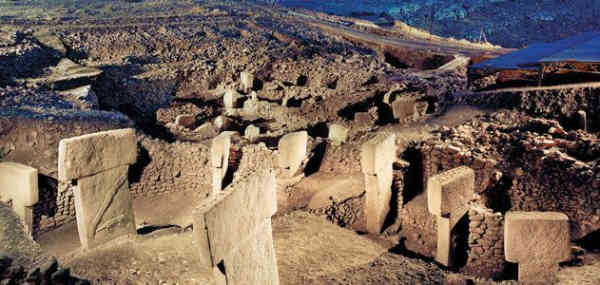The list of ”Top 10 archaeological attractions of Turkey” was created by Hürriyet Newspaper of Turkey. A committee consisting of more than 20 archeologists and tour guides contributed into the creation of this list.
1) World’s oldest temple: Gobeklitepe

The spot where the Euphrates and Tigris rivers met 12 thousand years ago witnessed one of the most important changes in human history. During this period, human beings were in the stage of transition from hunter and gatherer life economy to settled life. Considered as the oldest temple in the world, these structures, sculptures and reliefs in Gobeklitepe are unique in terms of their technical and aesthetic features. A must-see for those who want to understand how holiness, belief and aesthetics began and continue.
2) Troy
The Iliad Epic, written by Homer 2,700 years ago, tells about the city of Troy and its surroundings, for what the war was fought for 10 years. In the excavations carried out since 1863, the existence of 10 different cities was discovered in the settlement. History of Troy goes back as well as 5 thousand years. Troy, which is regarded as the birthplace of modern archeology in terms of the excavation history, answers the question of why there have been wars in the Dardanelles for thousands of years with its mythology and archeology. It is on UNESCO’s World Cultural Heritage List.
3) Mother Goddess Cult: Çatalhöyük
Catalhoyuk entered the UNESCO World Cultural Heritage List in 2013. It aroused great interest in that period with the excavations in the early 1960s. This is the biggest settlement of human beings where the transition from gathering to common settled life can be seen. The murals and famous mother goddess statues are the strongest cultural and artistic traditions of this period. It is the most important starting point for learning phenomena such as religion, the other world and mother goddess cult in the prehistoric period of Anatolia.
4) Hattusha
Hattusha (Hattuşa in Turkish) in Çorum city of Turkey today was the capital of the Hittite Empire, which ruled in a large part of Anatolia between 1650 and 1200 BC, and at times in a wide region extending to Northern Syria. When you visit the city, the city walls, gates, temple and palace ruins are the remnants which reflect the city’s brightest period. It is on the UNESCO World Heritage List.
5) Sagalassos
Sagalassos earned a distinct identity with archaeological excavations in recent years. You do not only see old buildings while wandering you also think “How is an archaeological excavation done?”, “How is the restoration of old buildings done?”. You can find answers for all these question in Sagalassos very well. That’s why Sagalassos is privileged. Although the history of the settlement goes back a lot, what is now visible on the ground reflects the splendor and prosperity of the Roman Empire Period.
6) Hasankeyf
Hasankeyf of the Middle Ages is integrated with its surroundings. At the summit, which is reached by passing through the housing pattern carved into the rocks, it is better understood how Hasankeyf and Tigris are integrated. First people settled here in the Neolithic Period around the 10th millennium, and became one of the most popular places in the region during the Artuqids period.
7) Pergamon
Pergamon, built on a hill overlooking the modern Turkish city of Bergama in Izmir (Smyrna), was the capital of the Attalid Dynasty, one of the Hellenistic Kingdoms of Anatolia. Pergamon city, which is one of the most important cultural and educational centers of the Hellenistic world, contains the most original attractions of Hellenistic Period Sculpture and architecture. Connected to Rome through a will in 133 BC, the city assumed the capital of Rome’s Asia State. Pergamon, which has existed until Byzantine and Ottoman times, entered the UNESCO World Heritage List in 2014.
8) Zeugma Ancient City and Museum
Located on the banks of the Euphrates, the Ancient City of Zeugma is where civilizations met. It is an important city established in the Hellenistic period for the fusion of Eastern and Western cultures. Zeugma is known for its unique mosaics, frescoes and treasures unearthed in the Roman Houses of Hellenistic and Greco-Roman culture. The works are exhibited in the Zeugma Mosaic Museum. Zeugma is also on the UNESCO World Heritage Tentative List.
9) Ephesus
Ephesus, built on the Meander River Delta, is the most famous ancient city of the Roman age of Anatolia. It has always been one of the most visited cultural attractions in Turkey. The Temple of Artemis, one of the seven wonders of the world, is the pride of the city. The Celsus Library, which served as both a library and a tomb monument during the Roman period, is located in the heart of the city. The House of Virgin Mary, where the mother of Jesus lived, is another popular attraction around Ephesus. An application was made in 1994 for the Ancient City to be included in the UNESCO World Heritage List and Ephesus was recently added on the list of UNESCO World Heritages.
10) Anazarbus in Adana
It is not easy to find such a magnificent photograph of history in harmony with the topography. It promises dizzying time travel in Adana, almost at the bottom of a castle coming out of fairy tales. Here in Anazarbus doesn’t seem to have many ruins except the castle structure, but don’t be mistaken! There is a whole Roman city is below and every house has capitals, sarcophagi, mosaics in its garden.
Visit Top 10 archaeological attractions of Turkey
I hope you liked the list of Top 10 archaeological attractions of Turkey. Contact me to learn more about attractions in Turkey and contact me to hire a professional licensed English-speaking tour guide in Turkey. See you soon, Hasan Gülday.